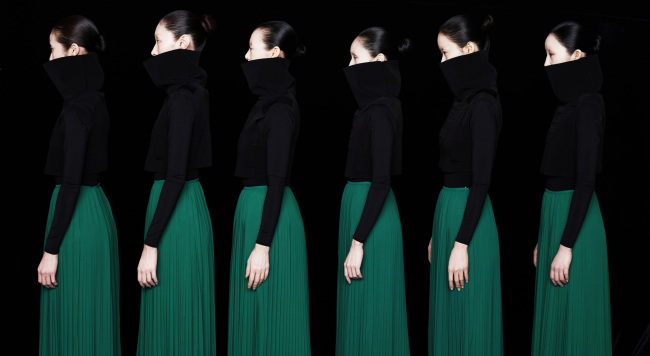‘Altar’: Traditional dance meets modern fashion
Fashion designer Jung Kuho stages his second dance piece
By Claire LeePublished : March 27, 2013 - 19:42
As if directing fashion brands KUHO and LEBEIGE wasn’t enough, it seems Jung Kuho can’t get enough of dance.
After the Korean National Ballet’s “Poise” last year, in which he participated as the stage art director and costume designer, Jung is ahead of his second dance show ― this time with the National Dance Company of Korea.
The state-run traditional dance troupe was founded in 1962 with the aim of creating and performing new dances based solely on Korea’s traditional dance.
The upcoming show, titled “Altar,” is to be choreographed by Ahn Sung-soo, who also choreographed “Poise.” Jung, on the other hand, will be directing the performance, and be in charge of the stage and costume design, music, hair and makeup, and lighting.
Though known for his minimalistic flair, Jung is no stranger to Korea’s traditional design. He created hanbok costumes for period dramas including director Chang Yoon-hyun’s 2007 work “Hwang Jin Yi,” a biopic about the eponymous Joseon courtesan. However, for the upcoming show, Jung is not designing hanbok, but directing a piece that features the East and the concept of shared and imagined Koreanness.
After the Korean National Ballet’s “Poise” last year, in which he participated as the stage art director and costume designer, Jung is ahead of his second dance show ― this time with the National Dance Company of Korea.
The state-run traditional dance troupe was founded in 1962 with the aim of creating and performing new dances based solely on Korea’s traditional dance.
The upcoming show, titled “Altar,” is to be choreographed by Ahn Sung-soo, who also choreographed “Poise.” Jung, on the other hand, will be directing the performance, and be in charge of the stage and costume design, music, hair and makeup, and lighting.
Though known for his minimalistic flair, Jung is no stranger to Korea’s traditional design. He created hanbok costumes for period dramas including director Chang Yoon-hyun’s 2007 work “Hwang Jin Yi,” a biopic about the eponymous Joseon courtesan. However, for the upcoming show, Jung is not designing hanbok, but directing a piece that features the East and the concept of shared and imagined Koreanness.

Last year’s “Poise,” in fact, should have been titled “Order” or “Harmony.” The dancers repeatedly created complete cosmos and chaos to the music of Bach and Shostakovich, moving beautifully in sync and then freely and spontaneously on stage.
Though working with a non-ballet troupe this time, Jung seems to continue focusing on harmony and dissonance: “Altar” has been described as blending yin and yang, the East and the West, and Korea’s traditional dance with ballet and contemporary movements.
One of the most striking elements about the show, arguably, is the music. Jung is said to have mixed sinawi, a traditional form of Korea’s shamanic music, with Wagner’s opera “Tristan und Isolde.” The two very different genres of music, hard to imagine being mixed together, reflect the major themes of the dance well: While sinawi is usually improvised by a musical ensemble consisting of Korean instruments, the opera by Wagner is noted for its harmonic suspension.
The stage will be kept minimal but colorful ― all dancers are wearing black tops and green skirts, the colors that symbolize what is considered “Korean”; Jung is using a number of colors, including red and white, with a lot of black ― the dominant color of the show.
In the center of the stage, a huge altar is set serving as an artistic object that symbolizes power, religion and social hierarchy. The dancers deliver the state of confusion and disorder, while being controlled by the “altar” and the powerful.
“Altar” runs from April 10 to 14 at the National Theater of Korea in Jangchung-dong, Seoul. Tickets range from 20,000 won to 70,000 won. For more information, call 1544-1555.
By Claire Lee (dyc@heraldcorp.com)


![[Weekender] Geeks have never been so chic in Korea](http://res.heraldm.com/phpwas/restmb_idxmake.php?idx=644&simg=/content/image/2024/05/16/20240516050845_0.jpg&u=)


![[News Focus] Mystery deepens after hundreds of cat deaths in S. Korea](http://res.heraldm.com/phpwas/restmb_idxmake.php?idx=644&simg=/content/image/2024/05/17/20240517050800_0.jpg&u=)

![[Herald Interview] Byun Yo-han's 'unlikable' character is result of calculated acting](http://res.heraldm.com/phpwas/restmb_idxmake.php?idx=644&simg=/content/image/2024/05/16/20240516050855_0.jpg&u=)
![[KH Explains] Why Korea's so tough on short selling](http://res.heraldm.com/phpwas/restmb_idxmake.php?idx=644&simg=/content/image/2024/05/19/20240519050115_0.jpg&u=20240519162247)


![[Photo News] Seoul seeks 'best sleeper'](http://res.heraldm.com/phpwas/restmb_idxmake.php?idx=644&simg=/content/image/2024/05/18/20240518050098_0.jpg&u=)






